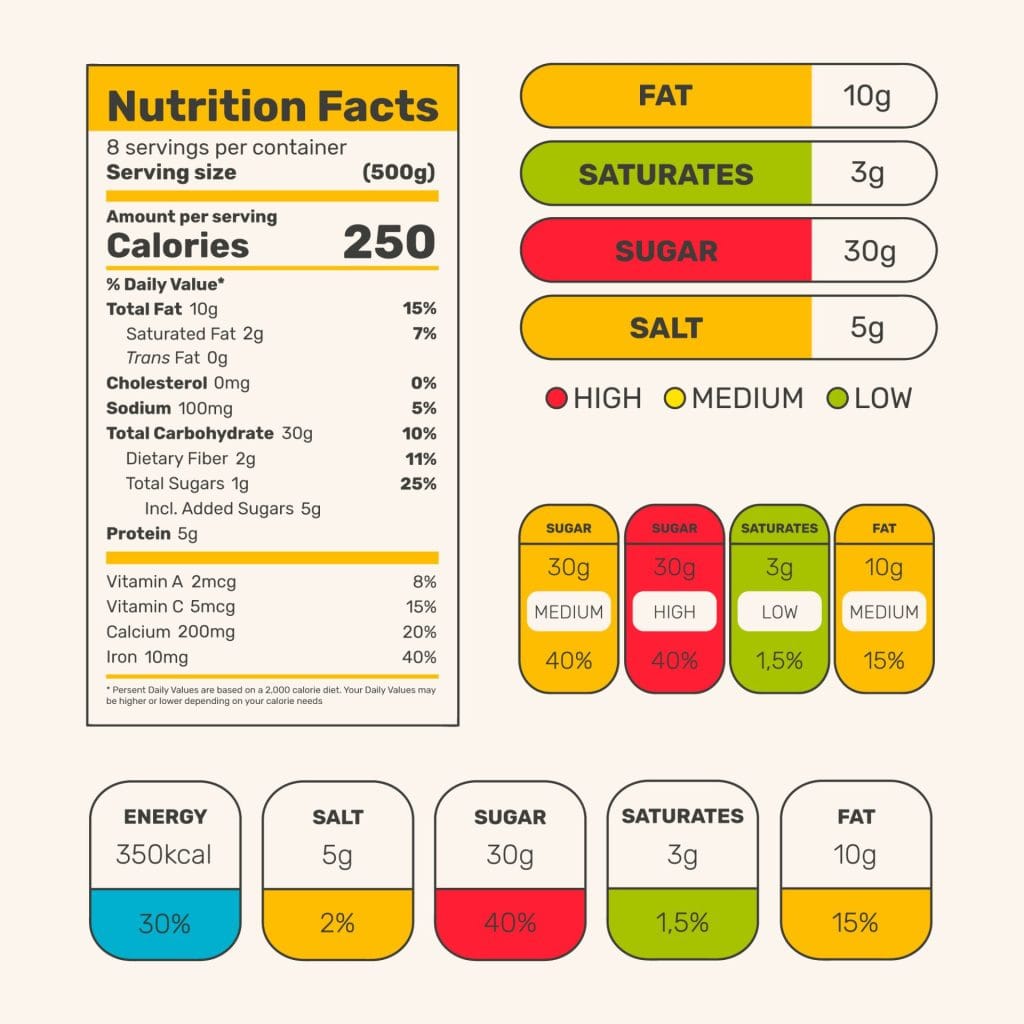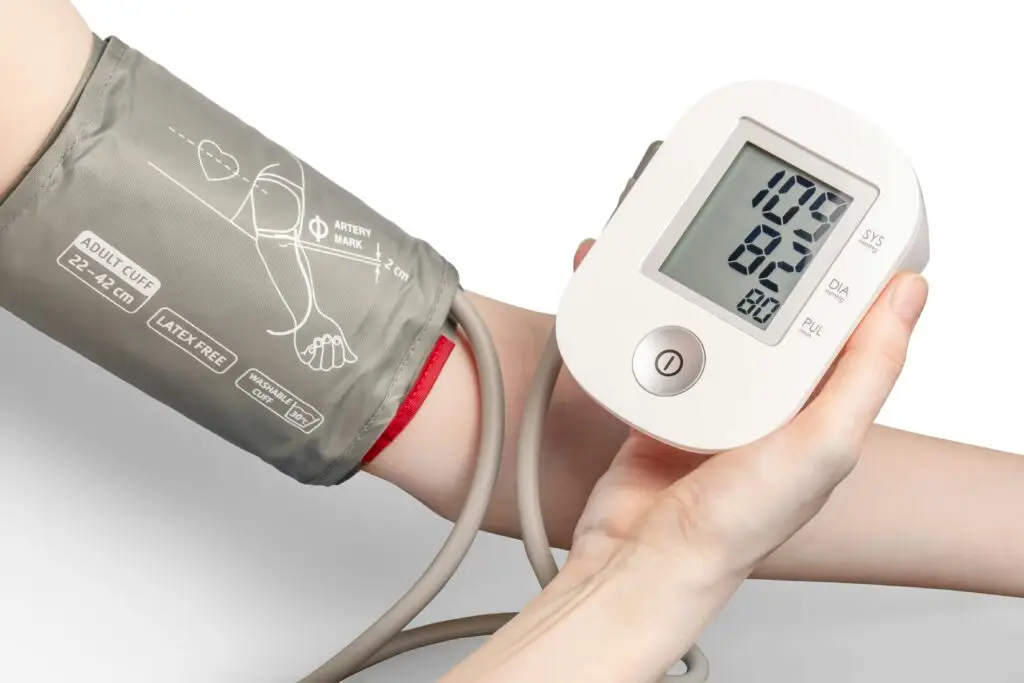
In today’s fast-paced world, food labels have become an essential tool for consumers navigating the supermarket aisles. Modern-day labeling, regulated by agencies like the FDA, aims to provide transparency about what’s inside our packaged foods, including nutritional information, ingredients, and health-related claims. However, these labels can often be tricky and confusing .
With clever marketing phrases, hidden details in fine print, and a barrage of scientific terms, it’s easy to misinterpret what’s truly healthy. For instance, a product might boast “low-fat” on the front while being loaded with added sugars in the back panel. This complexity arises from evolving regulations, such as the FDA’s 2020 updates to the Nutrition Facts label, which highlight added sugars and serving sizes more prominently to combat rising health issues like obesity and diabetes. Understanding these labels empowers you to make informed choices, avoiding deceptive claims and focusing on balanced nutrition for long-term well-being.
Understanding Nutritional Information and Ingredients

Food labeling is more than just a regulatory requirement, it’s a roadmap to what’s fueling your body. Mandated by the FDA, the Nutrition Facts panel decodes the caloric and nutrient content per serving, helping you align your intake with daily needs. Ingredients are listed in descending order by weight, revealing hidden additives or allergens. Decoding this in detail means starting with serving size, as it sets the baseline for all values; oversized portions can skew perceptions of healthiness. Look beyond buzzwords to the actual numbers: high sodium or trans fats might lurk in “healthy” snacks. This section breaks down key components to make sense of it all.
Calories
Calories represent the energy provided by food, essential for daily functions but easy to overconsume in processed items. On the label, total calories per serving are bolded for quick reference. For example, a 200-calorie serving might seem modest, but if the package contains multiple servings, you could unknowingly double or triple your intake.
- Aim for balance: Most adults need 2,000 calories daily, but this varies by age, sex, and activity level, use it as a guide, not a strict rule.
- Watch density: High-calorie foods with low nutrients (like sugary cereals) offer “empty calories,” contributing to weight gain without benefits.
- Context matters: Pair calorie info with activity; burning 300 calories through exercise allows room for nutrient-dense treats.
- Hidden sources: Beverages like sodas can add 150+ calories per serving without filling you up, leading to excess intake.
Carbohydrates, Fiber, and Added Sugars
Carbohydrates are the body’s primary energy source, but not all are equal, total carbs include fiber, sugars, and starches. Fiber aids digestion and satiety, while added sugars spike blood glucose without nutritional value. The label now separates added sugars to highlight artificial sweeteners.
- Total carbs: Limit to 225-325g daily on a 2,000-calorie diet; focus on complex sources like whole grains for sustained energy.
- Dietary fiber: Aim for 25-30g daily; high-fiber foods (5g+ per serving) reduce cholesterol and prevent constipation—e.g., oats or beans.
- Added sugars: Cap at under 50g daily; names like high-fructose corn syrup hide in yogurts or sauces, linked to insulin resistance.
- Net carbs: Subtract fiber from total carbs for low-carb diets, as fiber doesn’t raise blood sugar, useful for diabetes management.
Proteins
Protein supports muscle repair, immune function, and fullness. Animal and plant sources vary, but the label shows grams per serving without specifying quality—complete proteins (like eggs) provide all essential amino acids.
- Daily needs: About 46-56g for adults; athletes may need more—e.g., a 20g serving covers nearly half for women.
- Sources matter: Lean meats or legumes offer protein without excess fat; processed items might add sodium.
- Satiety boost: High-protein meals (15g+) curb hunger, aiding weight control, combine with veggies for balance.
- Overconsumption risks: Excess from supplements can strain kidneys; stick to food sources for vitamins like B12.
Fats
Fats are vital for hormone production and nutrient absorption, but types differ: unsaturated (healthy) vs. saturated/trans (harmful). The label lists total fat, with breakdowns for saturated and trans fats.
- Total fat: No strict limit, but aim for 20-35% of calories; focus on quality over quantity.
- Saturated fats: Under 20g daily to lower heart disease risk, found in butter or red meat.
- Trans fats: Avoid entirely; even “0g” means up to 0.5g per serving, accumulating from processed foods like margarine.
- Healthy fats: Unsaturated types (avocados, nuts) improve cholesterol; look for “0g trans” and low saturated fat.
Sodium
Sodium maintains fluid balance but excess raises blood pressure. Processed foods are major culprits, with labels showing milligrams per serving.
- Daily limit: Under 2,300mg; ideally 1,500mg for hypertension risks e.g., a soup serving might hit 800mg.
- Hidden in: Sauces, breads, or canned goods; “low-sodium” means under 140mg per serving.
- Health impact: High intake swells tissues, straining the heart, paired with potassium-rich foods to counter.
- Reduction tips: Rinse canned items to cut 40% sodium; choose “no salt added” versions.
How to Use % Daily Value
The % Daily Value (%DV) contextualizes nutrients based on a 2,000-calorie diet, helping gauge if a food is high or low in a component. It’s not one-size-fits-all, adjust for personal needs, like higher calcium for bone health.
- General rule: 5% DV or less is low (ideal for sodium/fats); 20%+ is high (great for fiber/vitamins).
- Quick comparisons: Use %DV to pick between brands e.g., cereal with 25% DV fiber beats one with 5%.
- Cumulative view: Track across meals; 100% DV total means meeting daily needs, but avoid exceeding saturated fat.
- Customization: Pregnant individuals need more iron (adjust %DV mentally); consult apps for personalized tracking.
- Limitations: No %DV for protein (varies widely); added sugars’ %DV highlights excess, like 50% in a soda signaling overindulgence.
Examples of Health Claims on Food Labels
Health claims on food labels link specific nutrients or foods to reduced disease risk, but they’re strictly regulated by the FDA to prevent misinformation. These claims must be backed by significant scientific agreement or qualified evidence, appearing on packages to guide healthier choices. For instance, a claim might state that soluble fiber from oats, as part of a low-fat diet, may reduce heart disease risk. However, not all products qualify, foods must meet nutrient thresholds, like low saturated fat. Misleading or unauthorized claims can lead to recalls, emphasizing the need for scrutiny. Beyond authorized health claims, nutrient content claims describe levels like “low calorie,” helping compare products but sometimes oversimplifying nutrition.
List of Food Claims on Food Labels by Companies
Companies use various claims to market products, drawing from FDA-approved categories like nutrient content, health, and structure/function claims. These appear on everything from cereals to supplements, but always cross-check with the Nutrition Facts.
Natural:
- Often implies minimal processing without artificial ingredients, but the FDA lacks a strict definition, e.g., a “natural” yogurt might still contain added sugars.
Point: Not synonymous with healthy; check for preservatives; USDA regulates for meats (no artificial colors/flavors).
Low Calorie:
- Means 40 calories or less per serving, useful for weight management, like in,diet sodas.
Point: Serving sizes matter (tiny portions inflate claims); pair with nutrient density; avoid if it sacrifices taste via chemicals.
Low Carb:
- Typically under 9g carbs per serving, appealing to keto diets e.g., “low-carb” bread.
Point: Differentiate net carbs (subtract fiber); hidden starches possible; not always low-calorie due to added fats.
Light/Lite:
- 50% less fat or 33% fewer calories than regular, common in dressings.
Point: “Light” in sodium means 50% less; compare originals; sometimes compensated with sugar/salt.
Low Fat:
- 3g or less fat per serving e.g., skim milk.
Point: May increase carbs/sugars; focus on unsaturated fats; FDA requires disclosure if calories aren’t reduced.
Fat-Free:
- Under 0.5g fat per serving e.g., jelly beans.
Point: Often high-sugar; not calorie-free; trace fats round to zero.
Low Sodium:
- 140mg or less per serving, helpful for blood pressure.
Point: “Very low” is 35mg; “reduced” is 25% less; hidden in “unsalted” items.
High Fiber:
- 5g+ per serving e.g., whole-grain cereals.
Point: Aids digestion; “good source” is 2.5-4.9g; soluble vs. insoluble types vary benefits.
Sugar-Free:
- Under 0.5g sugars per serving.
Point: May use artificial sweeteners; check calories; not carb-free.
Organic:
- USDA-certified without synthetic pesticides e.g., fruits.
Point: Not necessarily healthier nutritionally; higher cost; “100% organic” vs. “made with organic.”
Gluten-Free:
- No gluten, safe for celiac e.g., rice products.
Point: FDA limit <20ppm; not low-carb; processed versions add fats/sugars.
Heart-Healthy:
- Implied via symbols or claims like low cholesterol.
Point: Tied to low saturated fat; e.g., oats for fiber-heart link; verify full label.
How to Figure Out Nutritional Facts
Now that you know food labels and claims, it’s crucial to dig into the facts. Companies often rename sugars, fats, and additives to obscure unhealthy elements. For sugars, look beyond “sugar” for 60+ aliases like dextrose or maltose in “healthy” granola bars. Fats might hide as “partially hydrogenated oils” (trans fats) in baked goods, despite “0g” claims allowing traces. The sections below detail these tactics.
Hidden Names for Sugars and Fats
Companies disguise sugars to downplay sweetness, using terms like evaporated cane juice or agave nectar e.g., a “natural” energy bar might list multiple for lower individual rankings.
- Spot patterns: If ingredients end in “-ose” (fructose), it’s sugar; fruit juice concentrates adds calories without fiber.
- Fat aliases: “Mono- and diglycerides” emulsify but contribute saturated fats; palm oil in “veggie” chips raises cholesterol.
- Portion tricks: Small servings minimize %DV, but real consumption multiplies issues e.g., a cookie’s 10g sugar becomes 30g for three.
- Marketing ploys: “No added sugar” ignores natural highs in dried fruits; “reduced fat” often boosts carbs.
Risks for People
Misinterpreting labels heightens chronic disease risks, as overreliance on claims ignores cumulative effects. For diabetes, hidden sugars cause spikes and increased insulin resistance
- Diabetes: Added sugars (>50g daily) impair glucose control; misleading “low-carb” with maltitol still affects blood sugar.
- Heart disease: High sodium (>2,300mg) raises blood pressure; trans fats, even traces, inflame arteries, FDA notes 20% risk reduction via better labeling.
- Obesity: “Light” products encourage overeating, adding calories; poor fiber intake from processed foods slows metabolism.
- Other issues: Excess saturated fats link to cholesterol buildup; misunderstanding leads to nutrient deficiencies, weakening immunity.
An Overview of Nutrition Facts for 4 oz Chicken Breast
A 4 oz serving of boneless, skinless chicken breast is a lean protein staple, offering about 110-130 calories, primarily from protein. Per USDA data: 0g carbs, 3g fat (1g saturated, 0g trans), 25g protein, 65mg cholesterol, 220mg sodium. It’s low in calories (6% DV), high in protein (50% DV), and provides niacin, B6, and selenium. Ideal for muscle building or weight loss, but season mindfully to avoid added sodium/fats.
Word from Dr. Zara
Understanding food labels is essential to live a healthy life. We consume a lot of things on a daily basis. Though I’m not a nutritionist, as a medical doctor I understand the effects of what we eat every single day. I advise each to take a careful look at the food label and try to decode if it’s something that is healthy to eat based on your health or your doctor’s advice.
Frequently Asked Questions
- What does the cross mean on nutrition facts?
The cross, often a dagger symbol (†), indicates a footnote. For added sugars’ %DV, it notes no established daily limit but recommends under 10% of calories; for others like magnesium, it means no DV is set. - How to figure out nutrition facts?Start with serving size, then check calories, %DV for nutrients, and ingredients. Use %DV rules: low (5%) for sodium/fats, high (20%) for fiber/vitamins. Apps or FDA guides help calculate totals.
- What are examples of health claims on food labels?
Authorized ones include: “Adequate calcium and vitamin D may reduce osteoporosis risk” or “Soluble fiber from whole oats may reduce heart disease risk” when part of a low-fat diet. - How do companies hide sugars on labels?By using names like corn syrup solids or barley malt—scan ingredients for multiples; added sugars line reveals total grams.
- Why is understanding food labels important for diabetes?
It prevents hidden sugar intake, stabilizing blood glucose; excess raises type 2 risk by promoting resistance—aim under 50g added daily. - What should I prioritize on the ingredients list?
First few items dominate; avoid if sugar/fat top the list. Look for whole foods; shorter lists often mean less processing.
- What does the cross mean on nutrition facts?

